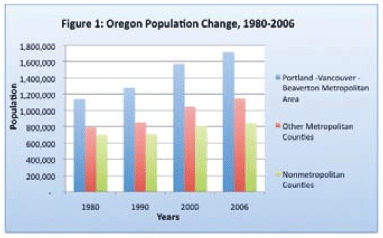
Once the bastion of a thriving rural middle class, Oregon’s rural communities are now barely scraping by. The state’s timber industry employed 81,400 residents at its peak in 1978. At the time, the industry made up 49% of all manufacturing jobs in the state according to the Oregon Employment Department.
Since then, the recessions of the early eighties and nineties, increased land-use restriction, decreased timber supply, global competition and automation of the timber industry have devastated rural communities that relied on once-plentiful timber jobs. Total timber industry employment has dropped to barely 11,000. Long term forestry prospects are glum. The benefits of carbon sequestration, endangered species protections, growing green building industry and the desire to protect Oregon’s forests for recreation will continue to hamper extraction and employment opportunities.
Meanwhile, residents of such places as the southwest town of Oakridge (pop, 4,000) are left with few options. As the last mill went in the early nineties, so did the jobs. Many left for employment in surrounding cities. Those who stay often work multiple minimum-wage retail shifts; a trailer or shared space is many times their only living option.
Oregon’s rural places were wrecked not just because of the necessary industry shift (away from logging) but because of the lack of long-term planning required to accommodate that shift.
The obvious decline in timber employment called for a multi-generational plan to re-invent the state’s rural communities. Instead, towns like Oakridge were allowed to sink until the situation became bleak enough to gain state attention. What followed was reactionary policy that mandated mostly welfare and other band-aid solutions.
The current situation calls for a more drastic plan that will once again restore Oregon’s proud rural tradition. The initial step is recognizing that rural Oregon – if the state is to preserve its natural resources and provide healthy communities for its residents – must transition from a rural layout to denser small town formations. The state lacks the resources, population density and geographic appeal to allow all of rural Oregon to make this change.
Instead, select areas with the potential for turn-around should be identified across the state and given special attention in making the transition. At best, this should come from the ground up: through the initiative of local communities. These “New Towns” will be allotted state resources and special legislation to reinvent themselves as more compact and sustainable communities with the capacity of attracting skilled workers and business alike.
Rather than attempt to wrestle with every factor in the discussion of the New Town model, what follows is a broad outline of the more crucial considerations suggested by such an approach . This leaves much open to discussion, to which the reader is invited to contribute.
First, Oregon’s historically strict land-use regulations need to be re-evaluated. Instead of discouraging development, it should be encouraged within the New Town boundaries by incentive packages to developers who add an element of “community value” to their projects. Projects that are built sustainably, offer employment, scenic access, cultural attractions, restaurants, and/or retail options will qualify for the incentives.
Of course many oppose almost any further development across rural Oregon. But in reality we really have two options: either accept a future of rural disenfranchisement and resource extraction; or concentrate resources, re-zone, and intelligently build new, economically as well as environmentally sustainable towns across Oregon.
Alternative energy companies such as SolarWorld, Vestas and Solaicx, Inc. are just a handful of the dozens of renewable energy companies running or planning new facilities in Oregon.
Initially, these firms have clustered around Portland or its surrounding suburbs. But factors such as dwindling space and access to workers could drive these firms further outwards. The right incentives package, inexpensive land and labor would make the New Towns an attractive option for the green industry in the coming years.
Green business could provide one foundation for these places. Once the green industry demonstrates confidence in the New Town model, other economic players would likely follow. These include industries – such as food processing, data centers and specialized services – that could also be nurtured successfully, as has occurred in smaller communities elsewhere in the region.
The New Town proposal also offers a viable solution to Oregon’s expected population growth. Between 1980 and 2006, the Oregon population grew from 2.6 million to 3.7 million, an increase of 40.5 percent. By 2050 population growth for the state is projected at 5.8 million according to the Northwest Rural Development Center using U.S. Census data.
The state’s population growth – mainly from immigration and domestic migrants – will be attracted to locales with affordable housing and job opportunities. So far this has translated into a largely urban migration. Growth within cities or in their surrounding suburbs increased by as much as 50%, while non-metro growth increased by only 19%.

As long as jobs remain in or near the handful of cities Oregon has to offer, these trends will continue. Fortunately, the majority of newcomers are not drawn primarily by urban amenities. Inexpensive housing, job opportunities, and scenic attractions could compensate nicely for the increasing cost and congestion that accompanies urban living.
The development of the suburbs stemmed from the desire to escape the urban core’s problems. The suburbs continue to surround our cities because of the resources and job availability. However, there is little reason that with the digital revolution and the coming green revolution, once-isolated towns cannot become self sustainable and very desirable.
Many readers will feel uneasy by the suggestion of deliberately spurring growth in particular places while allowing others to wane. It seems to go against free market ideology and even to be unauthentic.
Yet a change is needed. These places initially thrived because they were located near natural resources. By shifting from extraction industries, the basis of the local economy has shifted. The whole approach to town development needs to be readjusted to meet these new realities.
Without a complete shift in how planners view and design for the spaces across the entire state, the rural poor will continue to struggle, while population increases will make our metropolitan areas less and less attractive. The New Town model could present a viable option to the contemporary problems Oregonians face and perhaps to other problems now only on the horizon.
Ilie Mitaru is the founder and director of WebRoots Campaigns, based in Portland, OR, the company offers web and New Media strategy solutions.













Why?
"The current situation calls for a more drastic plan that will once again restore Oregon’s proud rural tradition."
Why? Why not let these towns disappear? This has happened all across the western USA over the last 150 years.
What is so important about a small rural town?
Dave Barnes
+1.303.744.9024
http://www.MarketingTactics.com